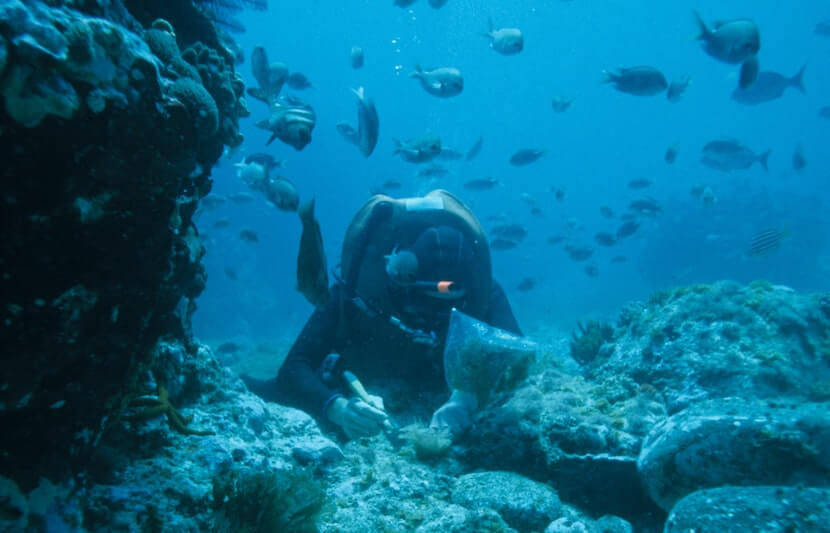In the darkness of the ocean’s twilight zone, 100 to 1,000 meters below the water’s surface, the ravenous appetite of tiny, single-celled organisms could play an unexpected role in altering Earth’s carbon cycle, according to a new study.
Led by Mike Stukel, an assistant professor of oceanography at Florida State University, a team of researchers has found that carbon-rich particles in the deep ocean, which would typically sink to the ocean floor and remain isolated for millenia, are instead being consumed by microscopic organisms called phaeodarians.
The researchers suggest this could cause carbon to re-enter the atmosphere after only a few months or decades and result in a large-scale effect on the global carbon cycle and Earth’s shifting climate.
The research is published in the journal Limnology and Oceanography.
The team also includes Tristan Biard and Mark D. Ohman from the Scripps Institution of Oceanography at the University of California, San Diego and Jeffrey Krause from the Dauphin Island Sea Lab and the University of South Alabama.
Recycling carbon
In order to investigate the process by which carbon is transported from the surface to the deep ocean, the team began research along the California coast from roughly San Diego to Santa Barbara.
“The deep ocean has the potential to store immense amounts of carbon dioxide,” said Stukel.
“However, the deep ocean does not directly mix with the atmosphere. Instead, the atmosphere exchanges carbon dioxide with the surface ocean, which is normally near equilibrium with the atmosphere with respect to carbon dioxide.”
Stukel further explained that when algae living on the surface ocean conduct photosynthesis, they take up carbon dioxide, which then draws carbon dioxide from the atmosphere to the surface ocean.
Then, when the algae is eaten by organisms such as krill or other zooplankton, these organisms breathe the carbon dioxide back out and return it to the atmosphere.
The only way the ocean experiences a net uptake of carbon dioxide from the atmosphere is if the organic carbon from the surface is transported to the depths of the ocean, typically in the form of sinking particles.
Sinking particles
Sinking particles can be a result of many things. Dead organisms, fecal matter or amalgamated packages of organic particles, for example, cause carbon to sink and be transported to the deep ocean.
Additionally, diatoms, a type of abundant phytoplankton that performs roughly a quarter of the world’s photosynthesis, have dense glass-like silica shells that cause them to sink quickly.
The researchers explain that if these sinking particles were to reach the deep ocean without obstruction, their carbon would be withheld from the atmosphere for hundreds of years.
But, as Stukel and his team discovered, this doesn’t always happen.
“There are many organisms (bacteria, crustaceans, fish — and the protists that we studied) that live at intermediate depths in the ocean and consume these sinking particles,” said Stukel.
“If these organisms consume sinking particles before they make it into the deep ocean, that carbon will be likely to re-enter the atmosphere after a period of only months to a couple decades.”
Investigating microorganisms
With the use of advanced Underwater Video Profiler (UVP) cameras, the researchers were able to investigate organisms as small as 500 microns, or half the thickness of a dime, and measure their role in consuming sinking particles.
Specifically, the team looked at a type of phaeodarian called aulosphaeridae, since it was easily detectable underwater and one of the researchers was an expert in identifying them through the UVP.
To calculate their consumption, the researchers quantified how many aulosphaeridae there were and how many particles they intercepted.
“By quantifying how many were there and then quantifying the proportion of particles they would be intercepting, we were able to calculate that they could be consuming as much as about 20 percent of the particles sinking out of the surface layer,” Stukel said in a statement.

The notion that one group of microorganisms could be consuming 20 percent of carbon-rich sinking particles suggests that microorganisms around the world could play a far bigger role in the carbon cycle than was previously believed, Stukel explained.
“The depth at which organic carbon (produced by algae in the surface ocean) gets respired back to carbon dioxide has a large impact on the global carbon cycle,” he said.
“Globally, if carbon dioxide is respired deeper in the ocean, atmospheric concentrations of carbon dioxide will decrease. Conversely, if it is respired shallower, atmospheric concentrations will increase. Thus understanding the processes that lead to respiration on sinking particles is very important.”
Continuing the study
Though the researchers only looked at aulosphaeridae, it’s not the only microorganism that plays a role in consuming sinking particles, and they plan to address others in the future, Stukel said.
Additionally, the researchers hope to better understand the variability in abundance of aulosphaeridae and similar organisms, as they found times when the organism would be so abundant as so consume up to 30 percent of sinking particles, and others when they were hardly present at all.
“The abundance of protists like Aulosphaeridae is potentially controlled by many different factors including temperature, oxygen concentration, food supply, predation, buoyancy, and ocean currents that are constantly moving these organisms around,” said Stukel.
“Understanding how these factors inter-relate requires long-term combined observations of changes in their ecosystem and their abundance.”
While the technology to count these organisms in the ocean has only existed within the past decade and the investigation is relatively new, Stukel believes the team’s discovery will be immensely important for understanding the carbon cycle in the future.
“Our ability to understand how these things will change is important in understanding how the global carbon cycle is going to shift,” Stukel said in a statement.
“We need to learn what’s going on in the rest of the world, and we need to know what causes these huge changes from when these organisms are a really dominant player to when they’re a marginal player.”



